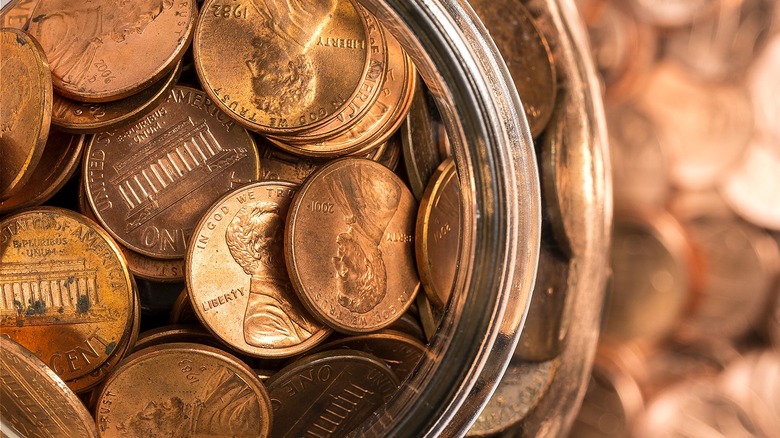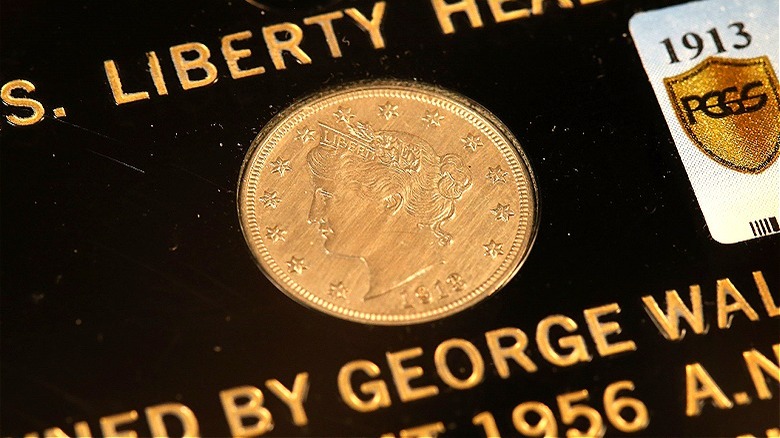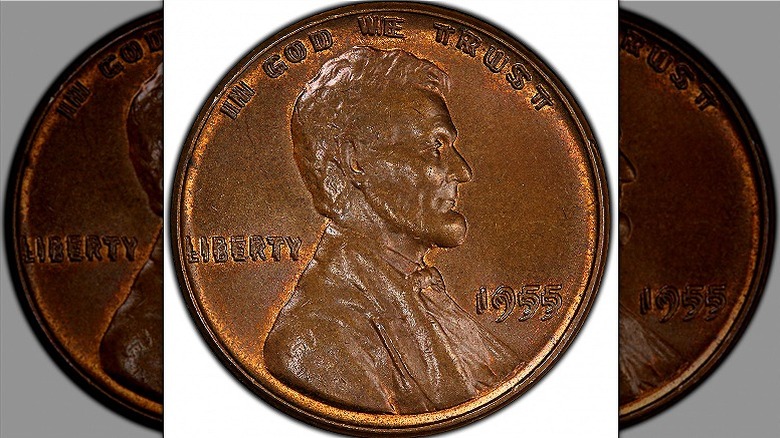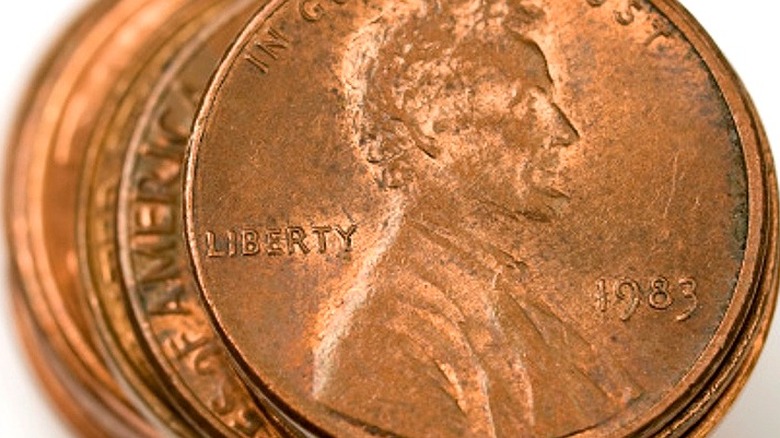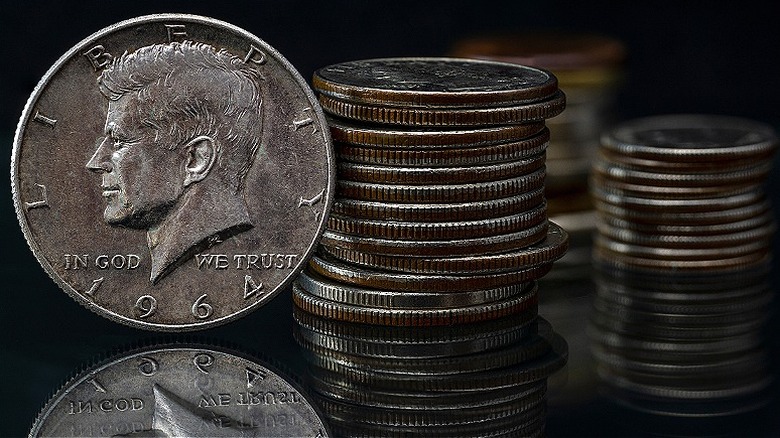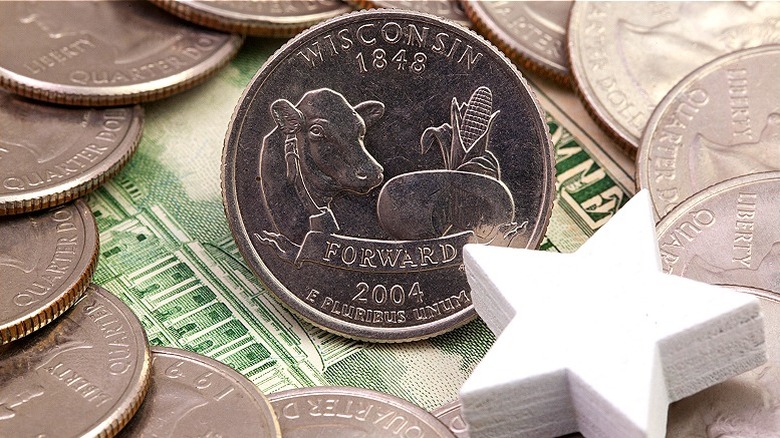Valuable Coins You Might Have Lying Around
The hobby of coin collecting, formally called numismatics, has been around for hundreds of years. As such, many of the most valuable finds — like a 1933 Double Eagle gold coin that sold for $18.9 million in 2021 — are well-documented in private collections or museums. However, it's still worth checking your change jar or junk drawer for rare coins, because there are some worthwhile examples still being pumped into laundromats or used to pay for a morning coffee at Starbucks or Dunkin'.
In fact, what if we told you there are some pennies from as late as the 1980s worth thousands of dollars each? As such, some collectible coin hunters take things one step further and actually buy rolls of coins from banks to search for that rare find. If nothing valuable is located, the coins can be redeposited or simply used for purchases, so the sole cost of this hobby is time. This said, the next time you find yourself with some time to spare, why not grab your favorite beverage, empty your pockets, and start searching?
1913 Liberty Head nickel
The origin story of the 1913 Liberty Head nickel isn't what you would call crystal clear. Several variations and theories exist, but one of the most popular tales is that five examples of the coin were created by an employee of the Philadelphia Mint, who also so happened to be a heavy-duty coin collector. As this particular story goes, in 1912, the U.S. Mint officially replaced the Liberty Head nickel with the Indian Head nickel, also called the Buffalo nickel. However, after the coin's design change, five additional Liberty Head nickels were secretly (and illegally) struck by mint worker Samuel W. Brown. These bespoke coins remained a secret until ~1919 or 1920 when Brown shared their existence with the American Numismatic Association. Some collectors theorize that Brown waited until then to allow a statute of limitations to expire and avoid possible prosecution for his clandestine activities.
An alternate and less-juicy backstory involves the five coins being struck as a test for gearing up production of the 1913 run of nickels. While the world may never know the absolute truth about the creation of the five 1913 Liberty Head nickels, their high collectible value is without question. In the early 1970s, it became the first coin to sell for over $100,000 but that's a mere pittance compared to nowadays. In 2022, GreatCollections announced that it had purchased one of the famed, ultra-rare coins for $4.2 million.
1955 doubled die Lincoln penny
The 1955 doubled die Lincoln penny isn't as valuable as some on this list, given that an estimated 20,000 to 24,000 examples were produced. Still, it has an interesting backstory and we'll bet you'd be more than happy to find one since they're worth up to $3,000 each, depending on the condition.
The minting error occurred when the design on the die was mistakenly doubled, resulting in two identical, but slightly offset, images on the coin. This is different from a "double strike" — when a coin is struck twice during the minting process — because the second strike typically flattens or obscures the first strike. While workers at the Philadelphia Mint caught the error before the coins were released to the public, since so many were already produced — some of which were already mixed in with non-error coins — the mint put the imperfect pennies into circulation anyway.
Reportedly, many of the 1955 doubled die Lincoln pennies were originally distributed inside the cellophane wrapping of cigarette packs. Since cigarettes cost 23 cents at the time and the vending machines only accepted quarters, dispensed packs contained a pair of pennies as change. If you're wondering, the nationwide average price of a pack of cigarettes today is about $8; an expensive, money-wasting habit to be sure.
1983 penny with no Mint mark
The 1955 doubled die Lincoln penny isn't the only valuable one-cent piece on our list. Witness, the more contemporary "penny with no mint mark" from 1983. Of the approximately 7.7 billion pennies made during 1983, only about 5,000 had this error. In actuality, there are two different errors in play on the same coin.
If you're ready to search your junk drawer for this rare penny from 1983, the first distinguishing feature is the namesake lack of a mint mark; that's the small letter underneath the date. For example, coins minted in Philadelphia should display a letter P. While not having a mint mark is indeed a minting flaw, the second quality that needs to be present for your coin to be a truly valuable 1983 penny is a doubling effect of the "one cent" text on the back of the coin. This was caused by the stamping machine hitting the penny in a slightly different location during its second strike.
So how much is the 1983 "penny with no mint mark" worth? The record-high sale price is $7,050 (auctioned in 2017 by Heritage Auctions), although value will certainly depend on condition.
Kennedy half dollars
Following the 1963 assassination of President John F. Kennedy, congress voted to bump founding father Benjamin Franklin from the half dollar in favor of the popular and much mourned Kennedy. In 1964, the Kennedy half dollars contained approximately 90% silver (as did their predecessors). With the price of silver hovering around $24 per ounce in March 2024, the high-silver content makes these early Kennedy half dollars and some other half dollars worth far more than their 50-cent face value.
From 1965 and 1970, the U.S. Mint got thriftier with its production of half dollars, but these coins still contain 40% silver, which makes them worth in excess of their face value, too. Note that while it's illegal to melt nickels or pennies, which cost more to make than they're worth, for their metal content, no such law protects half dollars.
At the time of this writing, the melt value of 1948 to 1964 half dollars is approximately $8.81 while half dollars from 1965 to 1970 are worth $3.60 for their metal content. Nobody, meanwhile, is going to be tempted to melt 1971-and-up half dollars, since they contain no silver and only have a value of about 10 cents, which is obviously less than the coins' face value. According to Coin Value Checker, certain Kennedy half dollars with manufacturing flaws could fetch $10,000 to upward of $150,000 from collectors, so you definitely wouldn't want to accidentally melt one of those.
2004 Wisconsin extra leaf quarter
In 1999, the Department of the Treasury famously started making quarters with special designs for every state in the union. By 2004, it was Wisconsin's turn to be featured on the 25-cent piece and as you might expect, the design focused on the Badger State's agricultural and dairy industry. The coin's design featured a cow, a wheel of cheese, and an ear of corn; it's that ear of corn that makes some examples of the Wisconsin quarter more valuable than others, because some have an extra leaf added.
At first, the extra leaf on some Wisconsin quarters was thought to be caused by an errant piece of metal or other flaw in the stamping process. Yet, that theory was discounted when it was noticed that some of the coins featured the extra leaf above the other leaves, while others featured the extra leaf underneath. Collectors finally agreed the most likely scenario was that an employee of the Denver Mint, where the error coins were made, added the extra leaf on purpose.
According to the Numismatic Guaranty Company Price Guide, these extra-leaf Wisconsin quarters are worth between $50 and $110 in used, circulated condition. Pristine examples, which haven't been circulated, can sell for up to $1,200.
